The 27 leopard gecko morphs on this list are some of the most commonly encountered ones. They have also served as a base for creating novel, wild, and wonderful leo morphs. And breeders are working on new morphs as we speak!
To make this article a special one, the morphs will be ordered not by the alphabet but by their coloration.
We’ll start with the most common colors and then cover mutations that impact patterns and size only. Then, we’ll move on to the most vivid morphs, rich in yellows and oranges. After the color spectacle, you’ll meet the less saturated but still highly attractive morphs, ending the list in Black-and-White style.
Also, the related morphs are clustered together.
Excited? You should be! Prepare your eyes for a feast!
List of the 27 Most Common Leopard Gecko Morphs
-
- Normal or Wild-Type
- Giant
- Jungle
- Stripe
- High yellow
- Hypo or Hypo Melanistic
- Super Hypo
- Albino morphs
- Tremper Albino
- Rainwater Albino
- Bell Albino Leopard Geckos
- R.A.P.T.O.R.
- Hybino or Hypo-Albino
- Sunglow
- Tangerine
- Carrot Tail
- Lavender
- Halloween Mask
- Mack Snow
- Super Snow
- Blizzard
- Murphy Patternless
- Banana Blizzard
- Diablo Blanco
- Black Night
- Black Pearl
- Enigma
Normal or Wild-Type
You can say that a normal, wild-type or natural leopard gecko is not a true morph since this is what leopard geckos originally look like in the wild. You don’t have to apply any selection, interbreeding, or crossbreeding to get a regular Leo.
Still, this natural Leo look can be decently variable and include more or less yellow, brown, or grey. Still, normal variety leos will always feature dark brown to black spots and markings, earning the species its common name.
Standard type leos are usually the ones that are the most readily available to buy, especially in general pet stores, and also the ones with the lowest price tags.
Giant


As the name suggests, leopard geckos with Giant mutations are bigger than average. Giants first occurred as a random mutation in Ron Tremper’s hatchery in 1999. Super Giant is an even larger version of the Giant morph – it is homozygous, meaning that Super Giants carry two genes for the Giant mutation. Temper’s largest giant, called Moose, measured 156 grams.
Because the mutation dictates only the body size, Giant morphs can also have other color mutations, resulting in various Giant color strains.
The phrase “gentle giant” can certainly apply to the Giant leos as they have a very calm, cool temperament.
Jungle


The term “Jungle” describes the wild pattern on the mutation carriers’ backs. Instead of regular dots and bands, a Jungle Leo has broken or incomplete bands, creating a swirly and slightly psychedelic pattern.
This now-classic mutation was discovered in 1991 by Ron Tremper. Its genetics are sort of complex and still unclear, sometimes making it hard to predict if the Jungle trait will be passed onto the offspring. Jungle co-occurs with other mutations or within other morphs. That way, you get, for example, a Tremper Albino Jungle specimen.
Stripe
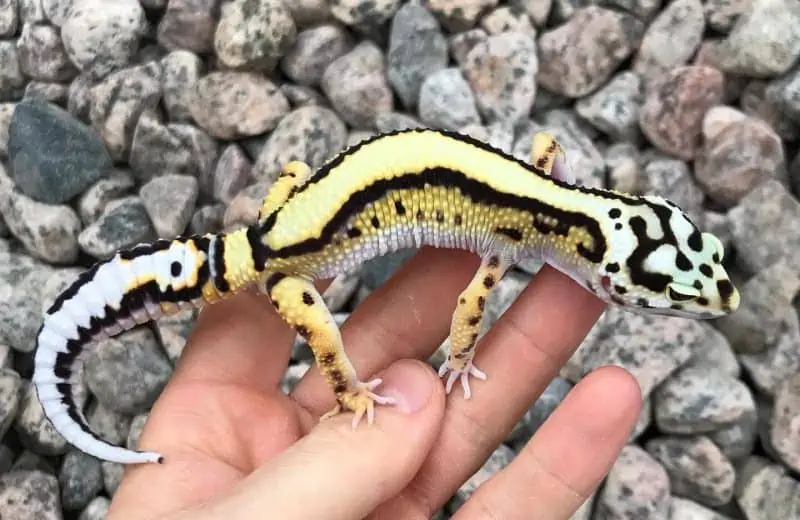

The Stripe morph has a distinct pattern with longitudinal stripes rather than the typical side-to-side lateral stripes. The longitudinal line begins at the neck and runs down to the tail, continuing along the length of the tail in some specimens. The neck ring, as well as the tail bands, appear broken.
Like Jungle, the Stripe pattern co-occurs with other mutations.
High yellow


As the name suggests, High Yellow is a morph that has more yellow pigment than an average natural Leo and was one of the first official morphs produced by captive breeding. The High Yellow still has dark spots, although fewer of them. However, the base body color is strongly yellow – much more yellow than in the case of an average normal counterpart.
Like Normal, the High Yellow is readily available to buy and is one of the affordable morphs.
Hypo or Hypo Melanistic
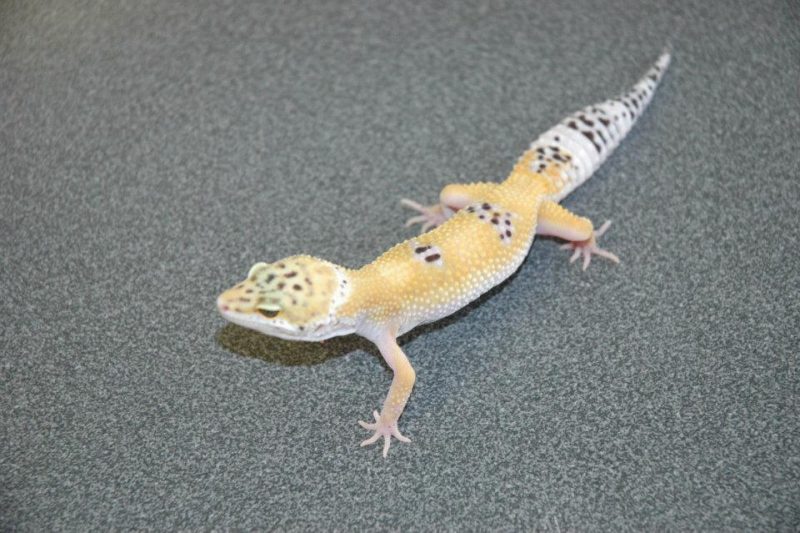

As the name suggests, Hypo morphs are distinguished by the reduction in melanin, the black pigment. Consequently, they have fewer dark markings. A Hypo is basically like High Yellow with ten or fewer spots on its body (by “body” I mean the back – head and tail are excluded from the count).
Super Hypo


Super Hypo is a variation of the Hypo morph that has no black spots on the body. The base color can range from a dull light yellow to bright yellow.
Note that many Super Hypos will look like Hypos until they mature and lose their spots as they enter adulthood.
Albino morphs
Albinism is a common mutation in the animal world. However, because of their visibility to predators, in the wild, albino animals rarely live long enough to carry the genes that cause albinism onwards.
However, in captivity, breeders have experimented with breeding different albinos and produced striking results.
It would be more precise to call albino Leos extremely amelanistic. That means they produce either no melanin or just tiny amounts of it, resulting in varying degrees of albinism. Since melanin only influences black color, albino leos can still have yellow, orange, and brown pigments.
There are three main types of albino leopard geckos: Temper Albino, Rainwater Albino, and Bell Albino.
Differentiating between these basic albino types is sometimes challenging, even for experienced hobbyists. Although it’s probably not the first thing that would occur to you, the most reliable way to tell them apart is by looking into their eyes.
Tremper Albino


Trempers, also known as Texas Albino, was bred by the famous Leo breeder Ron Tremper and were the first albino morphs to be established in leos ever. Accordingly, they dominate the Leo morph market.
Tremper albino eyes are pale or silverish, often with visible red veins. However, when the gecko is young, it can be pink.
What also makes Tremper albinos stand out is that they have more brown markings on them when compared with other albino types.
The most notable Tremper albino morph or sub-type morph is probably the R.A.P.T.O.R. morph.
Rainwater Albino
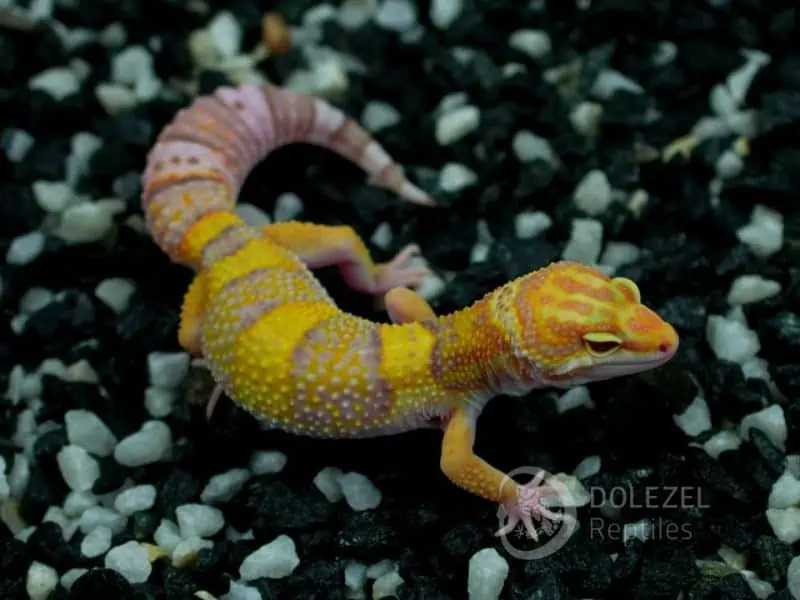

Rainwater Albino is also known as Las Vegas Albino (festive, right?). They are paler, pinkish, smaller, and have darker eyes than other albino morphs. Their name has nothing to do with rain, but with the fact that Tim Rainwater created the morph in 1998.
Bell Albino Leopard Geckos


Bell albinos are the newest addition to the albino Leo cluster of morphs. They feature characteristically pink eyes, lavender or soft-yellow base color, and scarce, small brown spots.
Interesting fact: Each of these albino types have a mutation on a different genetic allele. What that means in breeding practice is that you have to breed within one type only to get albinism in the offspring. If you breed, e.g., a Bell albino to a Temper Albino, the result will be normal-looking offspring or unpredictable mutations.
R.A.P.T.O.R.
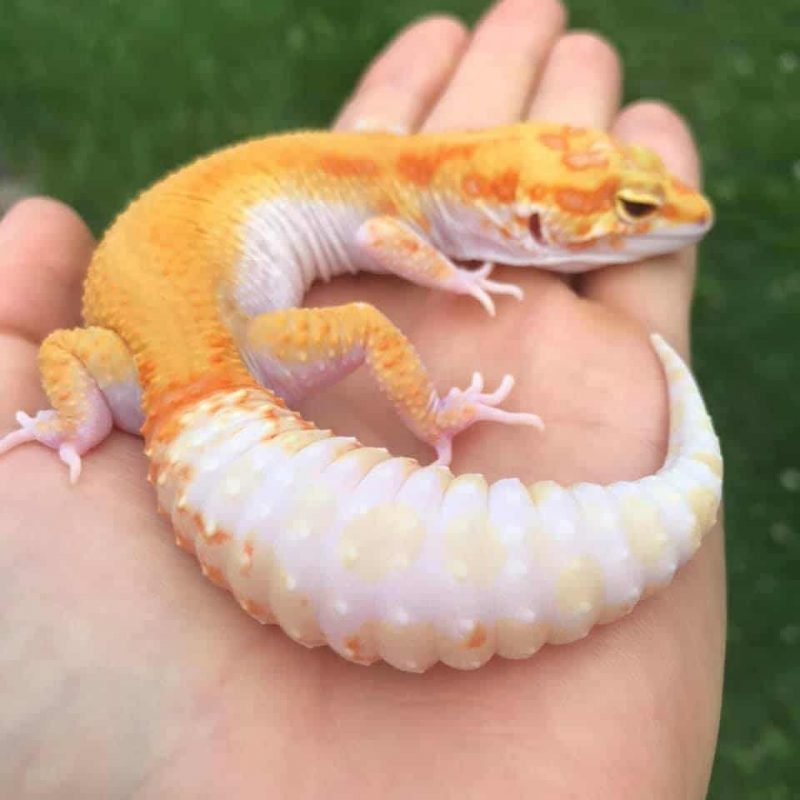

RAPTOR is probably the most well-known Tremper albino variety.
Although a dinosaur was the first thing that came to your mind, in this case, RAPTOR is an acronym for Red-eye Albino Patternless Tremper Orange. The name contains all the significant traits of this morph – RAPTOR Leos are Tremper albino, patternless, orange, and have solid red eyes.
Hybino or Hypo-Albino
Up until this point, I’ve introduced you to the concept of Hypo morphs and Albino morphs. But what happens when you mix the two?
This is where Hybino or Hypno-Albino leos enter the picture. Hybino is a combo of Super Hypo and any of the three albino strains. In general, they have an all-yellow body and albino-like eyes, which vary depending on the albino strain used in the breeding.
Sunglow


Sunglow leos are a Hybino subtype bred from a Super Hypo and Tremper Albino. Accordingly, they have a bright yellow or orange body color (hence the name) and typically Tremper albino pale-silverish-reddish eyes. The tails can be banded or spotted.
Tangerine
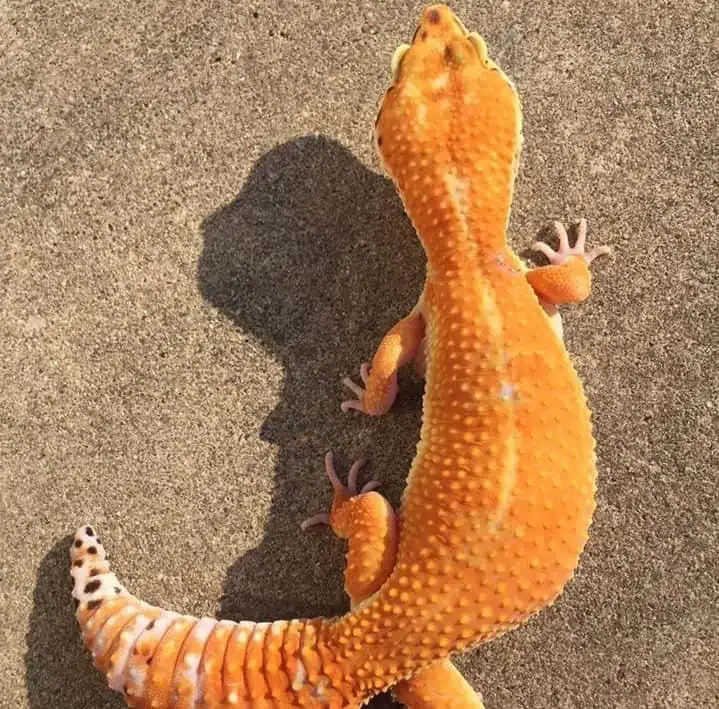

Tangerine morph is characterized by strong orange color, and that is pretty much its only defining characteristic. Patterns can vary greatly, with various orange patches, brown spots, and interesting and unique tail patterns that feature orange, yellow and white.
Tangerine morph is often used to define other distinct morphs that feature orange coloration.
Carrot Tail


As you might assume by the morph’s name, the Carrot tail is defined by the presence of orange coloration on the gecko’s tail. By definition, carrot tails must have at least 15 percent of their tail colored orange.
Did your eyes get tired from all the crazily bright colors and patterns?
Let’s search for some beauty in the milder leopard gecko morph tones.
Lavender
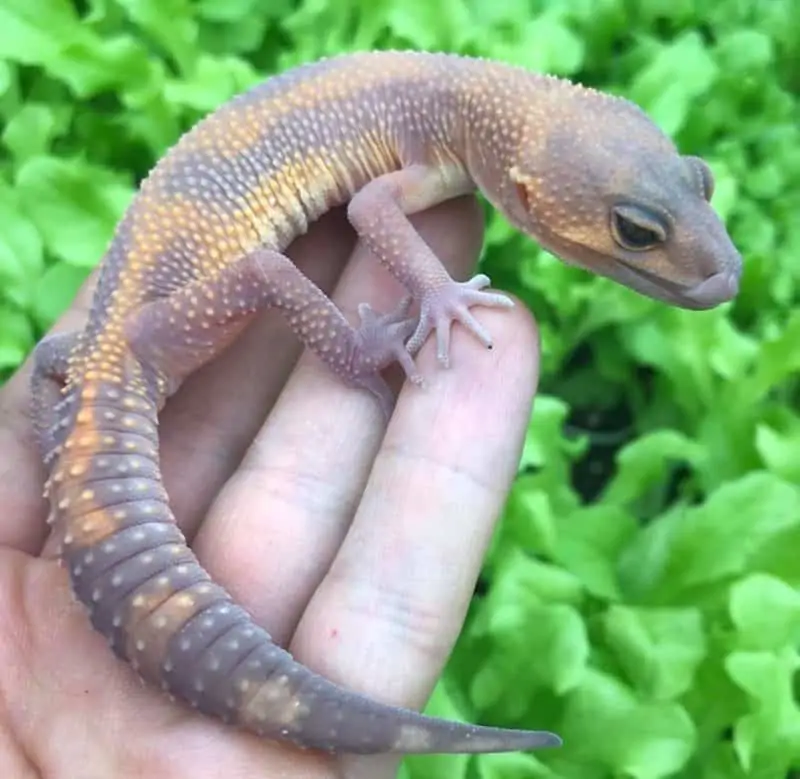

Lavender leos have a light-violet body, and that is their defining characteristic. Other traits can vary, and Lavender can occur along with various other colors and within different patterns.
JMGReptile developed the first Lavender line in 2003 by breeding Stripes and Normals that showed varying amounts of Lavender coloring. Since then, Lavenders can be created from other genetic combinations.
Halloween Mask


The name of this 90s morph was inspired by strong and unusual patterns on the Halloween Mask leo’s head. The patterns change and develop as the lizard matures.
The colors are usually white to yellow with white-based tails and irregular, dark, and bold markings on the body. It is said that high-quality Halloween Masks can change their color depending on their mood, temperature, and other environmental factors – they can go from dark melanistic hue to vibrant yellow coloration.
Mack Snow
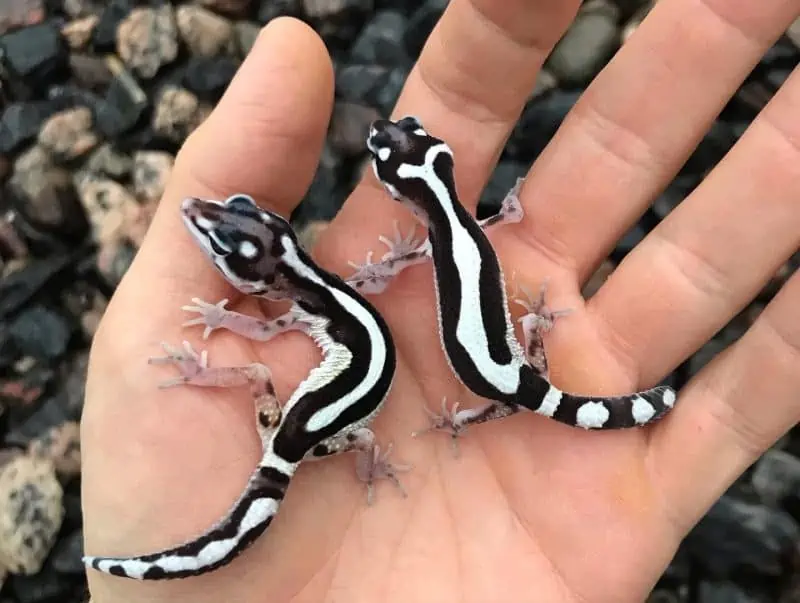

One of the most popular leopard gecko morphs, Mack Snow, was first bred by John and Amy Mack. Mack Snows lack bright colors such as orange and bright yellow. Their base color is white or pale yellow, with black spots or bands. Their color often darkens with age.
Super Snow


While Mack Snow is a heterozygous mutation, Super Snow is its homozygous version. Super Snows are lighter in color, usually white, almost never yellowish. Their spots are smaller and denser, looking like speckles.
Blizzard


If you ever wanted to name your pet gecko “Snow White”, then Blizzard could be the morph you were looking for.
Blizzard leopard geckos are patternless, with only one solid, light color. The hue can be completely white, but also have a yellow or a purple overtone. However, things get dark with the Midnight Blizzard, a dark version of any of the said hues.
Blizzards are also known for their eclipsed or solid black eyes.
Murphy Patternless


Murphy Patternless is a morph extremely similar to Blizzard – so similar that it is often difficult to tell them apart, especially in adulthood. However, young Blizzards are born completely patternless. Murphy Patternless has blotches that fade over time. Some adults will keep the extremely faded markings.
Despite the superficial similarity, the genetic makeup of the two morphs is quite different.
Banana Blizzard
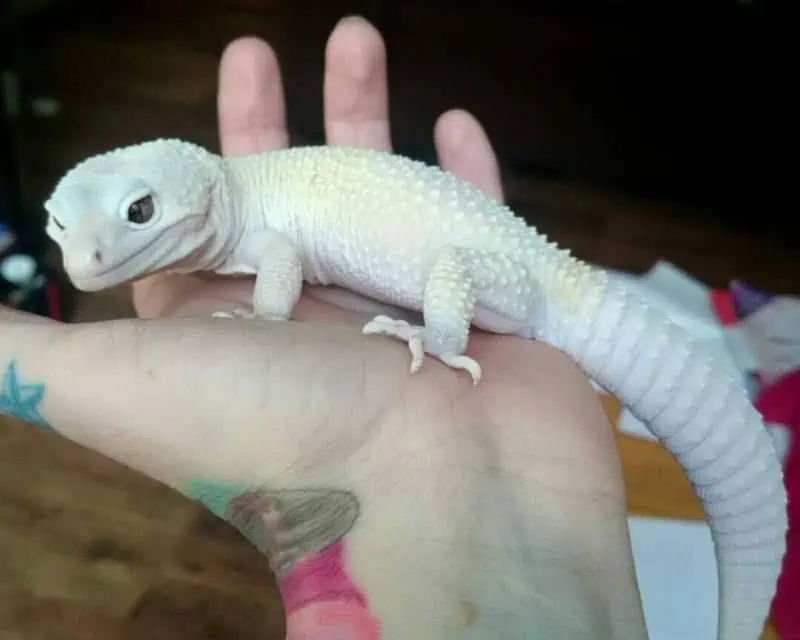

Crossing Blizzard and Murphy Patternless rarely deliver extraordinary results since the mutations are not compatible. Still, the Banana Blizzard is a quite handsome homozygous morph that results from this crossbreeding. It exhibits a larger amount of bright yellow pigment than the parent morphs, and that’s exactly where it got its Banana-inspired name.
Diablo Blanco
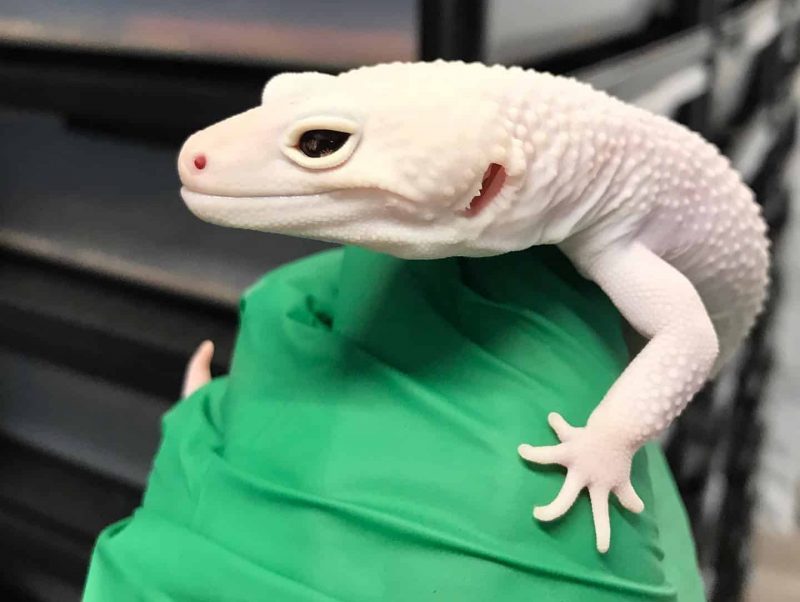

The “White Devil” morph is the combination of RAPTOR and Blizzard, with features of both morphs. Diablo Blanco is patternless, solid white to pinkish-white, and it has the RAPTOR’s distinct red eyes. That’s one creepy Snow White there!
And now we’re going to take a U-turn – from the whitest of the whites to the blackest of the black morphs.
Black Night


Black night was the first true melanistic morph to appear on the market.
“Melanistic” means that their skin has a higher-than-average concentration of melanin, the black pigment. That makes the Black Night, and as we’ll shortly see, the Black Pearl leos, much darker than their counterparts and the complete opposite of albino morphs.
Black Night leos have a very dark, nearly black color with a brown tint. They usually have spots and other markings, but sometimes they can have a solid color too. They always have contrastingly white bellies.
Because of the rarity of this morph, Black Pearls can get very expensive, ranging from $1000 to over $3000.
Black Pearl


While Black Night has brown to dark yellow markings and an overall brownish tint, Black Pearl has a less warm, grayish tint, pushing the color of this morph more towards true black. Because of the specific texture, it is also known as The Black Velvet.
Also, Black Pearl has distinct white pearl-like papules (bumps on the skin).
The luxurious name of this morph reflects not only its looks but also its price. Melanistic leos are among the rarest and the priciest morphs on the market. A female black pearl (only females are sold) costs around $3000!
Bonus: The Controversial Enigma Morph – Yay or Nay?
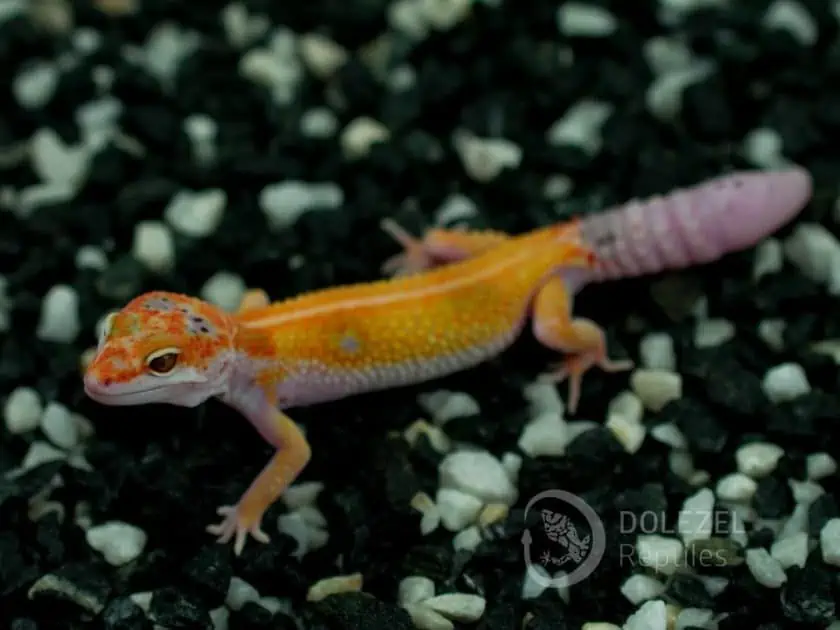

Enigma is undoubtedly a beautiful leo morph. The completely or nearly completely white tail and the faded, non-uniform, speckled pattern on the back make Enigma highly interesting and unique on the leopard gecko morph market. Also, it has inspired numerous crossbreeding experiments.
However, Enigma has one major issue. It is the only leopard gecko morph with a well-documented potential for developing a major health issue.
What is Enigma Syndrome?
The enigma syndrome is a neurologic condition that occurs in Enigmas and their crosses. Stress or irritation are the triggers, but sometimes it will develop without any major event.
Enigma syndrome causes leos to “stargaze” with their head tilting backward uncontrollably, spin in circles, do “death rolls,” and even have seizures. Also, affected Enigmas will have wobbly gates and general trouble with coordination. The condition seems highly uncomfortable and causes the affected individuals to lose their appetites and even stop feeding completely.
Leos affected by the Enigma syndrome must be kept in a very basic and non-stimulative setup to avoid triggering the disease onset.
The severity of the condition has caused a debate in the leopard gecko community about whether the Enigma morph should be discarded due to this prevalent issue. Some breeders have stopped working with Enigmas, and I fully understand why.
Although Enigmas are still widely available to buy, I would never recommend you to get one. Although they are adorable by their looks, the risk of a stressful and untreatable neurological problem is just not worth it.
What Are Leopard Gecko Morphs?
Note: This section to the end was written by Ben Team
The term “morph” is colloquially used to describe reptiles that display a genetic mutation. It isn’t a scientific term, but it is commonly and consistently used among reptile keepers, so we’ll continue to use it from here on out.
Note that the term is most properly applied to animals that display a specific trait, such as albinism or a striped color pattern. It does not apply to animals who exhibit a specific, polar trait; it does not apply to physical characteristics that vary along a continuum.
In other words, a gecko that is slightly larger than the others, or displays slightly more dots than most is not a good example of a “morph.” But an animal that lacks all melanin (meaning that it is amelanistic or “albino”) is a good example of a morph.
Patterns of Inheritance
Most genetic mutations are passed on to an animal’s offspring in one of several ways. By understanding the different ways mutations are inherited, you can predict the likely results from a given mating.
But before going further, let’s pause for a moment and review some basic genetic information:
- Leopard geckos have two copies of each gene in their DNA
- Each parent provides one copy of each gene
- Mutated genes are called alleles, and they’re often (but not always) associated with morphs
- Different morphs are passed on to their offspring in different ways
Now that you’ve had a chance to refresh your memory on the basics of genetic inheritance, we can talk about the most common patterns by which mutations are passed on. The four most common patterns include:
Dominant
Dominant traits are relatively rare among commonly kept reptiles, but they’re also the easiest to understand. If an animal possesses a dominant allele, it displays the visual appearance associated with the gene, whether it has one copy of the gene or two.
Simple Recessive
Simple recessive genes only alter the appearance of an animal if they occur in pairs. Heterozygous animals can produce morphs, but they look completely normal and indistinguishable from animals that do not possess the allele in question.
Co-Dominant/Incomplete Dominant
The terms co-dominant and incomplete dominant technically refer to slightly different things, but they are often used interchangeably by reptile keepers. Essentially, these traits will alter a gecko’s appearance when present, but those with two copies of the gene typically display a more extreme version of the trait.
Polygenetic
Polygenetic traits are controlled by a set of several different genes (or collections of genes). Accordingly, these types of traits are inherited in very complex, unpredictable ways. You could argue that polygenetic traits shouldn’t be considered morphs, but breeders have varying opinions about the practice.
Can Your Combine Different Morphs?
Part of the appeal of color morphs is that you can combine them. You may, for example, pair animals in such a way that you produce individuals who are not only albino but striped too. Accomplishing this, however, is not always easy. The math gets pretty complicated pretty quickly, and it’ll usually take multiple generations to achieve the intended results.
For example, if you intend to combine two recessive traits, you’ll need to start by breeding a pair of adults that exhibit each trait. The male may exhibit trait A, while the female will exhibit trait B.
All of the offspring from such a pairing should be heterozygous for each trait – they should all have one copy of the gene that creates trait A and one that creates trait B. However, as we are talking about recessive traits, all of the offspring will look normal.
You’ll then need to raise a pair of these animals to maturity and breed them together. The resulting offspring will represent any of nine different genetic combinations:
- Normal A Genes, Normal B Genes
- Heterozygous A, Normal B Genes
- Homozygous A, Normal B Genes
- Homozygous A, Heterozygous B
- Normal A Genes, Heterozygous B
- Normal A Genes, Homozygous B
- Heterozygous A, Heterozygous B
- Heterozygous A, Homozygous B
- Homozygous A, Homozygous B
Examining the Results of a Multiple-Morph Breeding
In the above example, the first example would be completely “normal” – they don’t have either of the mutated genes in question. Statistically speaking, you should expect each egg to have a 1/16th chance (6.25%) of producing a completely normal gecko.
But you can’t look at these animals and distinguish them from those in groups 2, 5 or 7 – animals which are heterozygous for one or both of the morphs in the colony. These animals – those that are heterozygous for one or both of the traits – occur about 50% of the time. One out of four eggs should be heterozygous for both, while one out of eight should be heterozygous for one or the other.
Before going further, note that all of the offspring discussed so far look entirely normal – 56.25% of all the eggs the pair in question produce.
Those in groups 3, 4, 6 and 8 will display one of the morphs, but they may or may not be heterozygous for the other trait – but you won’t be able to tell which is which by looking at them. These animals, who display at least one of the morphs in question, will represent about 37.5% of the offspring produced.
And finally, for your multi-generation efforts, you will enjoy a 6.25% chance (1 in 16) of producing an animal that displays both traits.
Hopefully, this illustrates why animals that display two recessive traits are relatively rare and, often, expensive. You could also try to cross recessive traits with co-dominant or dominant traits, but it would alter the expected offspring produced.
A Note of Caution
Some morphs look surprisingly similar, yet they are actually created by two completely different genes. The “albino” trait in leopard geckos is a great example of this.
There are three different types of albino leopard gecko, produced by three different genetic mutations. They are typically referred to as the “Tremper,” “Rainwater,” and “Bell” lines (each is named after the original breeder). Each produces a slightly different appearance, but they all have the characteristic “albino” look.
However, because they are all controlled by different genes, they’re not compatible with each other. Breeding a “Tremper” albino to a “Rainwater” albino, for example, will produce normal looking offspring, who are heterozygous for each trait.
There’s nothing wrong with these types of similar-looking mutations that are caused by different genes, but it is important to know that this phenomenon exists.
***
I began working with leopard geckos shortly after I was introduced to the world of reptiles. I was working in the reptile department of a large pet store, and the owner purchased an entire breeding colony from a local hobbyist. He essentially handed me the keys to the project and told me to get to work producing offspring.
I worked with the colony for the next two years (we eventually sold the adults to another keeper), and thoroughly enjoyed myself. This was more than 20 years ago, so the only morph we had in the colony was a male-female pair that were heterozygous for amelanism (albino).
Nevertheless, I thoroughly enjoyed working the colony – especially the daily ritual of peeking into the incubator to see if anyone had hatched overnight. Usually, the lizard looking back at me was a normally colored individual, but every so often, the genetic dice gifted me with a set of ruby red eyes (a trait of amelanistic geckos) looking right back at me.
Today, leopard gecko breeders surely enjoy this feeling even more, as they have dozens of different morphs at their disposal. Some enterprising breeders likely even combine morphs in new ways, that have never occurred on the planet.




4 Comments
Thank you very much for such an easy to read and understand informative guide! Genetics always left my poor brain like mush and has always been beyond my reach of comprehension. But I believe I’m beginning to understand them due to your clear and concise article. I will definitely follow up and subscribe. Now if you could do the same with other lizards!
I got my first leopard geckos a couple months ago and fell in love with them. I just bought a few more. If I send pictures would you be able to help me determine what morphs I have and how to determine what they will produce?
Hi Tiffani, I recommend you join Facebook groups for morph IDs.
Hi Tiffani,
What can I say – 20 years later, I’m still in love with my leos, so I understand entirely! What’s there not to love? While we would enjoy seeing your pets, I recommend you get involved with active leopard gecko groups on Facebook and post pictures there – the community is supportive and knowledgeable, and they might be more equipped to help you. Also, if you got your leos from a reputable breeder facility, they will surely be able to tell you more about their genetics. Good luck